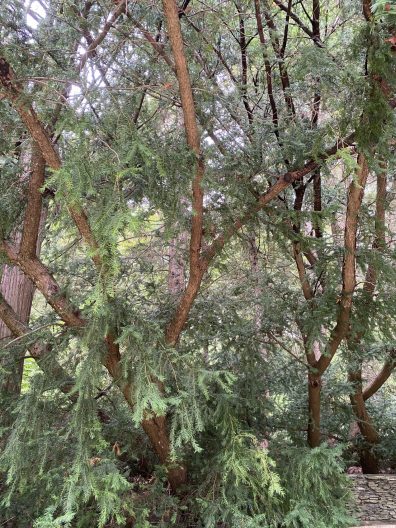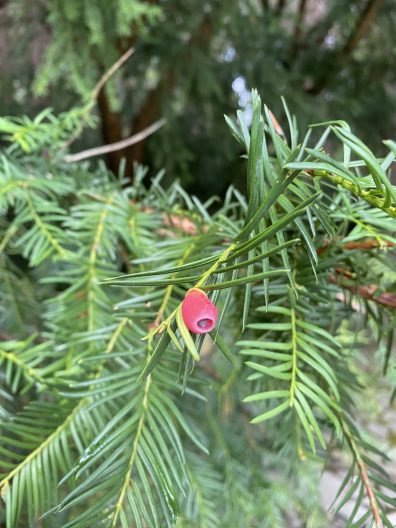Plant Profile: Taxus brevifolia

Scientific Name: Taxus brevifolia
Common Name: Pacific yew, western yew
Family: Taxaceae
Native Range: Western coast of the United States, from southern Alaska to northern California; western Rocky Mountains, from northern British Columbia to Idaho and Montana
Location in the Arboretum: South end of the Arboretum above Azalea Way (Grid 17-1E)
The Pacific yew, Taxus brevifolia, is a native tree or large shrub that is often overlooked below the overstory of large iconic Pacific Northwest trees such as Western redcedars, Douglas firs, and Western hemlocks. In Seattle we are more likely to know and appreciate the English yew, Taxus baccata, a slow growing evergreen with forms and cultivars more appropriate for landscape settings. Beneath its often scraggly looks, however, the Pacific yew has an important story to tell about plant-derived medicine and the importance of plant conservation.
Pacific yews are found along the west coast from southern Alaska down to northern California and along the western slopes of the Rocky Mountains from southern British Columbia south into Idaho and Montana. They are usually a minor component of the understory, but occasionally form thick stands. The trees are evergreen with needle-like leaves, distinctive reddish-purple peeling bark, and small, berry-like, bright red fruit (arils) on the female plants, which are toxic to humans but eaten by many birds.
In the late 1950s the National Cancer Institute partnered with the US Department of Agriculture to screen plant and animal samples for possible use as cancer drugs. In 1962 a botanist named Arthur Barclay was working in the Gifford Pinchot National Forest which extends around Mount Rainer National Park, south past Mount Saint Helens and Mount Adams, and all the way to the Columbia River. He and his graduate students collected samples of Pacific Yew for the cancer screening project. These samples were sent to a lab in Wisconsin where analysis revealed a promising anti-cancer compound, which was named Taxol.

Extracting Taxol was difficult, requiring stripping the bark and killing the tree in the process. It quickly became clear that sourcing Taxol from Pacific yew trees was not going to be sustainable. Treating a single cancer patient might require killing eight 60-year-old yew trees! In tandem with clinical trials, researchers raced to find methods of isolating Taxol without harvesting the bark of the trees.
In 1992 after successful clinical trials, Taxol was approved by the FDA for use against ovarian cancer. Since then it has also been approved for use against several other cancers including breast cancer. In 1994 the first chemical synthesis of the drug was successful, however it still produced low yields of the drug. Currently production of the drug is semisynthetic, done with a variety of methods including using the needles of the English yew, and other yew species without killing entire trees. Research is still being done to bolster production of this lifesaving drug in sustainable ways.
You can find a grove of beautiful mature Pacific yews planted around the Milburn Memorial at the south end of the Arboretum above Azalea Way (Grid 17-1E). Although you are not likely to find them at your local garden center, or see them planted in landscapes, these native trees have immense value as the source of a drug that has saved thousands of lives. Over half of the drugs currently prescribed by western doctors have their origins in plants! Plant conservation is important not just for ecosystem health, but also for human health. How many more lifesaving drugs are waiting to be discovered in the wild corners of our planet? Next time you see a scraggly Pacific yew, take a moment to reflect on how dependent we are on plants for our health.
Sources:
https://pubsapp.acs.org/cen/coverstory/83/8325/8325taxol.html?
https://www.news-medical.net/health/Paclitaxel-Production.aspx
Kumar P, Singh B, Thakur V, Thakur A, Thakur N, Pandey D, Chand D. Hyper-production of taxol from Aspergillus fumigatus, an endophytic fungus isolated from Taxus sp. of the Northern Himalayan region. Biotechnol Rep (Amst). 2019 Nov 15;24:e00395. doi: 10.1016/j.btre.2019.e00395. PMID: 31799144; PMCID: PMC6881681.
https://www.acs.org/education/whatischemistry/landmarks/camptothecintaxol.html#pacific-yew
https://www.cancer.gov/research/progress/discovery/taxol